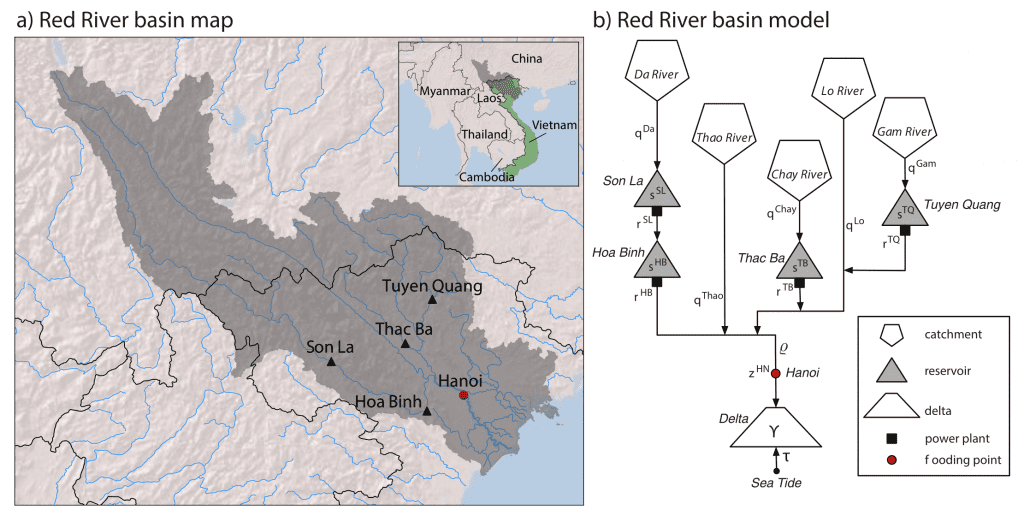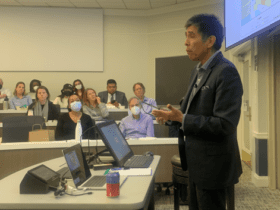Around the world, freshwater resources sustain agricultural, industrial, and ecological systems. Meeting these multi-sectoral demands simultaneously requires tradeoffs. This is certainly true in the Red River Basin in East Asia, the second largest river basin in Vietnam, see Figure above of the Son La reservoir in Vietnam (photo Matteo Giuliani)
The Red River gets its name from the reddish-brown color it takes on during the monsoon season, when sediment from the underlying silt is carried downstream. These monsoonal flows fertilize the river’s agricultural delta and help support Vietnam’s agricultural economy, which employs 70% of the population [1]. The river and its monsoonal floods also support major fisheries and aquaculture. As such, the Red River’s freshwater resources are essential for food security in the region. However, while the Red River’s monsoonal flows play a critical role in the vitality of the region, they can also cause devastating floods. The capital city of Hanoi is particularly vulnerable, as it is situated in the heart of the Red River delta. In 2002, the UN Development Program estimated average annual flood damages in the delta at 130M USD, with 50M USD in Hanoi alone [2

To manage flows in the Red River, the Vietnamese government has constructed several reservoirs upstream of Hanoi. Four of the largest reservoirs are shown in the map below. These reservoirs capture large flow events before they flood Hanoi. They also store up water for times of drought, increasing irrigation reliability in the dry season, and they provide hydropower production for Vietnam’s growing energy demands.
A key challenge, however, is that different reservoir operations are optimal for different objectives resulting in water management tradeoffs across sectors. Maintaining low reservoir levels favors flood protection, as this leaves open capacity to capture oncoming flood waves. In contrast, maintaining high reservoir levels favors hydropower production, as it enables a large head differential above and below the dam. High reservoir levels also ensure there is sufficient water supply to meet agricultural, municipal, and industrial demands in times of drought.
Alternative reservoir operations not only present conflicts between different human objectives; they also present conflicts between human and environmental objectives. The very construction of dams can drastically change the geomorphology of the basin, impeding larvae and sediment passage downstream and hampering fish migration upstream or down [4]. While some of these impacts are irreversible, reservoir operations can reduce others by attempting to reproduce the natural hydrograph [5].

As if balancing the competing objectives outlined above is not challenging enough, Vietnam will also have to grapple with how to manage water in the region under climate change. Sea level rise will exacerbate flood risks in the delta that cannot be controlled by upstream dams. The resulting saltwater intrusion will also degrade water quality in the delta’s irrigation canals, leading to potentially harmful agricultural yield reductions. While these risks are expected and can be prepared for, it is uncertain how the monsoon will be affected by climate change, making adaptation planning for reservoir operations harder. Most climate projections suggest there will be increased monsoonal precipitation, but also greater intra- and inter-annual variability, which will increase the risks of both floods and droughts [7].
Through multi-objective optimization, we hope we can help inform the design of dynamic, adaptive policies to balance conflicting water demands in the basin under an uncertain and potentially trying climatic future.
Julianna Quinn is an Assistant Professor at UVA’s School of Engineering and Applied Sciences. Her work applies concepts of mathematics to improve the management of environmental systems, with a special focus on water systems.
References
- Nguyen, T. C., Do, N. H., Nguyen, T. H. & Egashira, K. Agricultural development in the Red River delta, Vietnam – Water management, land use, and rice production. (2002).
- Hansson, K. & Ekenberg, L. Flood mitigation strategies for the Red River Delta. (2002).
- Quinn, J. D., Reed, P. M., Giuliani, M. & Castelletti, A. Rival Framings: A Framework for Discovering how Problem Formulation Uncertainties Shape Risk Management Tradeoffs in Water Resources Systems. Water Resources Research (In Review).
- Wild, T. B., Reed, P. M., Loucks, D. P., Mallen-Cooper, M. & Jensen, E. D. Balancing Hydropower Development and Ecological Impacts in the Mekong: Tradeoffs for Sambor Mega Dam. Journal of Water Resources Planning and Management, 145, 05018019 (2019).
- Sabo, J. L. et al. Designing river flows to improve food security futures in the Lower Mekong Basin. Science 358, eaao1053 (2017).
- Schmitt, R. J. P., Bizzi, S. & Castelletti, A. Tracking multiple sediment cascades at the river network scale identifies controls and emerging patterns of sediment connectivity: TRACKING MULTIPLE SEDIMENT CASCADES AT RIVER NETWORK SCALE. Water Resources Research, 52, 3941–3965 (2016).
- Hijoka, Y. et al. Chapter 24: Asia, Working Group II contribution to the IPCC Fifth Assessment Report. in 1858–1925 (2014).





